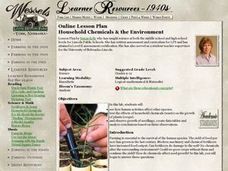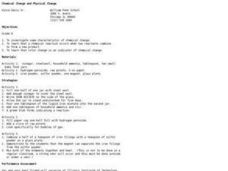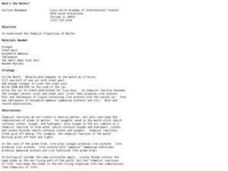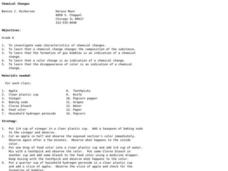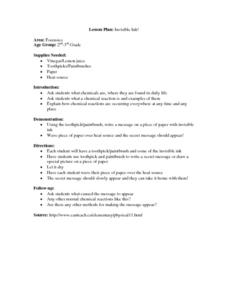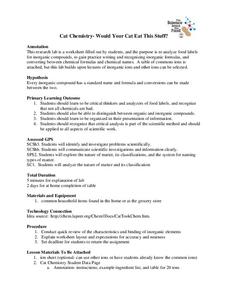Curated OER
Household Chemicals & the Environment
High schoolers conduct a laboratory experiment designed to investigate the effects of chemicals, soil quality and pollution on seed growth and plant yield. They consider how best to maximize agriculture in the long term.
Curated OER
Chemical Formulas
Young scholars assess how to go from writing ionic chemical formulas to nomenclature and naming chemical compounds. They brainstorm former studies and share their thoughts in small groups. A list of everyday products (shampoos,...
Curated OER
Chemical Change and Physical Change
Sixth graders combine chemicals to create a chemical change. In this chemicals lesson plan, 6th graders will investigate characteristics of chemical change by combining chemicals. They will learn that color change is an indicator of...
Curated OER
Hazardous Chemicals in Your Neighborhood
Students examine the effect of hazardous chemicals on humans. They discover how the chemicals are cleaned up and the facilities in their neighborhood. They identify federal and local agencies that oversee environmental hazards
Curated OER
Physical and Chemical Changes
Students investigate chemical and physical changes. In this physical and chemical change lesson plan, students perform 3 experiments in the lab to observe changes in matter. They determine that no new substances are formed in physical...
Curated OER
ToxMystery Lesson Plan 1: Introduction to Common Household Chemical Hazards
Students participate in ToxMystery, a computer game, where they discover potential environmental health hazards in rooms of a common household. In this lesson plan on household safety, students first brainstorm possible hazards in the...
Curated OER
What's the Matter? (Living and Non-Living Things)
Understand how chemical reactions recombine atoms to create the "chemicals of life". An experiment, showing the basic chemical reactions of an iron nail or a match, helps young children start their understanding of permanent changes.
Curated OER
Acids and Bases: Cabbage Juice Indicator
Fifth graders perform tests to identify acids and bases. For this chemistry lesson, 5th graders identify common household substances as acids or bases using cabbage juice indicator strips.
Curated OER
ToxMystery Lesson Plan 2 : Case Book: Catch That Hazard!!!
Students explore toxic hazards. In this personal health lesson, students discover appropriate uses for household chemicals as they identify potentially harmful products in their homes.
Curated OER
Hazardous Chemicals? Not in my Water!
Students reflect on the effects of their actions on the environment. For this community service lesson, students investigate the hazardous quality of products within their homes. Student educate their families and communities about the...
Curated OER
Close Encounters
Students investigate the cause of death of a fictitious school janitor. They develop hypotheses based on information discovered by examining the labels of household chemicals.
University of Georgia
Antacid and Uncle Heartburn
Household materials can be used for more than cleaning! In this collaborative experiment, emerging chemists use products such as vinegar and liquid antacid to explore chemical reactions that commonly occur in the human body.
Virginia Department of Education
States and Forms of Energy
Energy is just energy, right? Explain various forms of energy to your young scientists by using an interactive experiment that contains common objects to demonstrate complex concepts. Pupils conduct experiments for radiant, thermal,...
Curated OER
Chemical Changes
Students compare types of chemical change. In this chemical reaction lesson, students use a variety of household items to investigate different types of chemical change. Students will engage in a discussion about the dangers of chemicals...
Curated OER
Chemical Changes
Sixth graders explore chemical and physical changes. In this lesson plan about chemical changes, 6th graders observe various items and changes that occur at certain times. Students determine what change took place and observe the change....
Curated OER
Chemical Formulas and Naming
Students practice naming and writing formulas for simple chemicals. After a review of vocabulary, they create ion flash cards and discuss the rules for writing chemical compounds. They practice naming and writing the formulas based on...
LABScI
Stoichiometry: Baking Soda and Vinegar Reactions
Examine the concept of stoichiometry using common household products. Scholars perform chemical reactions and measure the reactants and products. They compare their measurements to predictions made from the chemical equations.
Curated OER
Sometimes, solid + liquid = gas
Third graders experiment with common household liquids and solids. In this chemical reaction lesson, 3rd graders discuss phase changes and experiment to find other ways to create gases. They use water, vinegar, lemon juice, flour, baking...
Curated OER
Controlling Substances
Students consider their own understanding of household safety, examine the latest remedy deemed poisonous by physicians, and research the hazards of household products. They create public service announcements regarding potential hazards.
Curated OER
Invisible Ink!
Students explore how chemical reactions occur. After a brief discussion of household chemicals and how they work, students prepare a solution of invisible ink. Students create a message with their ink and watch the reaction as their...
Curated OER
How Do Toxins Affect the Human Body?
Students study toxins. In this biology lesson plan, students identify toxins contained within household products and determine specific affects that toxins may have on the human body.
Curated OER
Investigating the Types of Energy in Different Objects
Students investigate forms of energy. In this physical science energy lesson, students work with a partner classifying household items according to the type of energy they have. Students complete a related worksheet.
Curated OER
Household Toxic Chemicals
Students take a home toxins survey and determine possible substitutions for household toxins.
University of Georgia
Would Your Cat Eat This Stuff?
Processed foods use inorganic compounds for flavoring and preservation. This take-home laboratory challenges scholars to find 20 different compounds identified on the labels of foods to list on their data collection sheet. The activity...


